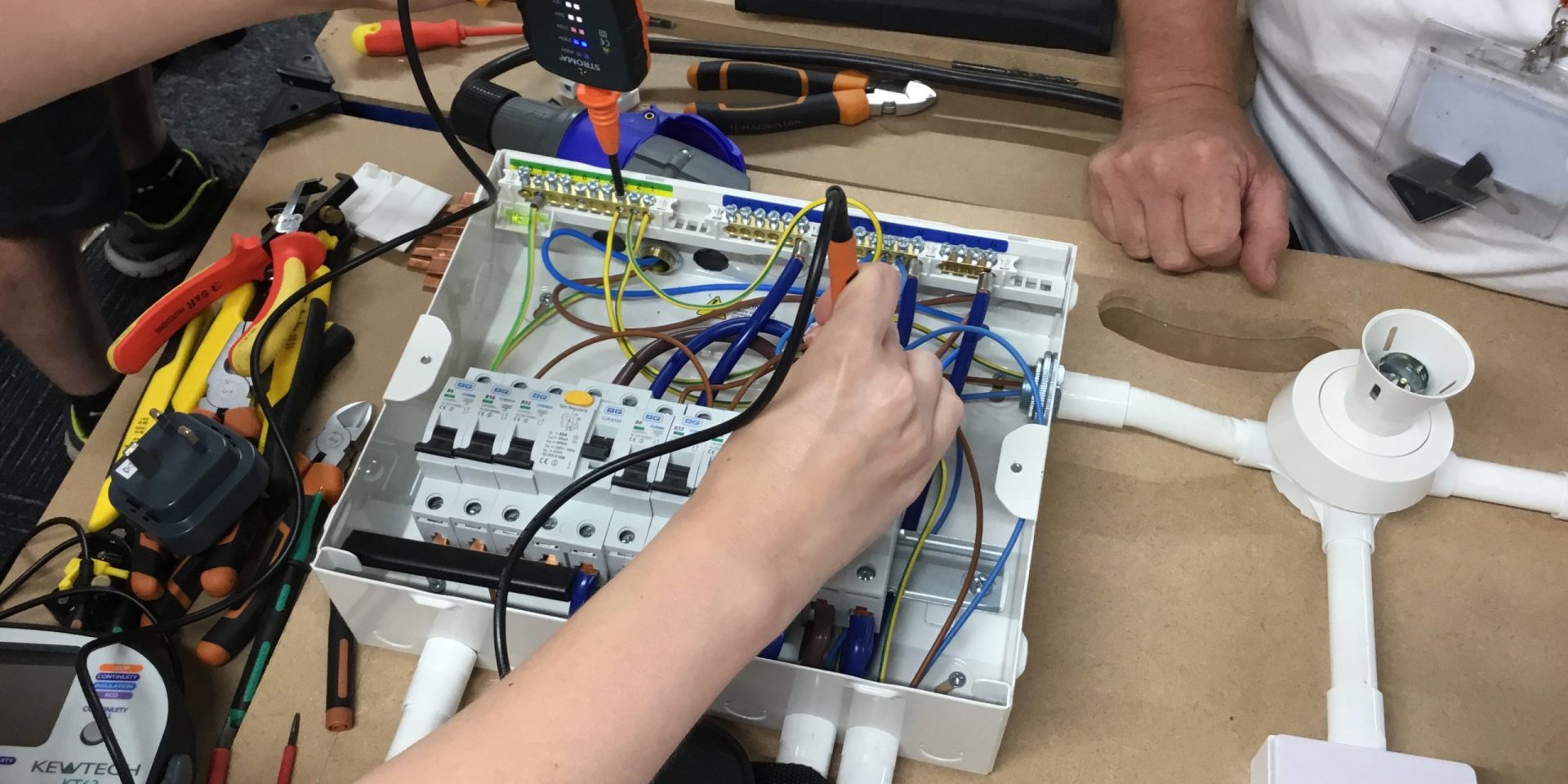Guide to Electrical Wiring Colours in the UK
For obvious safety reasons, the UK has adopted standardised colour coding for different wires within cabling, and knowing how to read this colour code is vital for electricians of all levels, professional and amateur.
In this guide, we’re going to look at the electrical wiring colours in the UK, why they’re important, when they were introduced and why the old system was abandoned, as well as the difference between single- and three-phase wiring and some common mistakes to avoid.
If you’re an aspiring electrician, looking for a door to a rewarding new career or a seasoned pro who wants to take their learning to the next level, check out our range of electrical training courses.
Why Understanding Wiring Colours is Important
There are two main reasons why understanding wiring colours is important: safety and regulatory compliance.
Safety – Let’s imagine there are no standardised wiring colours. You’re on a job and you open the outer insulation of some cabling – how do you know which one’s live? Or neutral or earth for that matter? Knowing which colours mean what will keep you safe, as well as protect the person who comes across your work next time.
Compliance – Like we mentioned, wiring colours are standardised for good reason, and this colour code is strictly enforced. Ensuring your wiring work is compliant with current regulations means you need to understand how to recognise UK wiring colours, so you know which colours to use and how to connect cabling correctly.
Types of Wires and Their Roles
Twin and Earth (T&E) Cable – This flat cable is commonly used for domestic wiring installations including lighting and socket circuits.
Armoured Cable (SWA) – With an armoured casing, this type of wire is perfect for underground or outdoor applications.
Fire-Resistant Cable – In the case of a fire, fire-resistant cabling can withstand the heat to ensure that vital systems such as alarms, emergency lighting and fire suppression systems can remain active.
Low Smoke Zero Halogen (LSZH) Cable – LSZH cabling is designed not to emit smoke or halogen gas when exposed to fire, for enhanced safety in areas such as schools, hospitals and public transport.
Flex Cable – Common in domestic and commercial settings, this cabling features multi-stranded conductors and is designed to withstand frequent movement, making it ideal for appliances like kettles.
Heat Resistant Cable – Certain appliances generate a lot of heat during their usual operation, such as cookers and boilers, requiring cabling that can withstand the high temperatures.
Mineral Insulated Copper Cable (MICC) – MICC is highly fire-resistant, making it ideal for fire alarm systems, emergency lighting and certain industrial applications. It features copper conductors, a copper sheath and magnesium oxide insulation.
Three-Core and Earth Cable – With three insulated conductors, these cables are designed to accommodate multiple switches on the same circuit, such as where several switches are required for one light.
Submersible Pump Cable – Designed with water resistance in mind, submersible pump cable is suited to providing power to submersible pumps for wells and water systems.
Single-Core Cable – Featuring a single insulated conductor, single-core cable is used for general wiring applications, including inside devices, distribution boards and switchgear.
SY Cable – This is a form of multi-core cable, only it features a steel wire braid for protection from mechanical impacts, making it perfect for industrial environments.
YY Control Cable – Specialising in reliable signal transmission, this flexible multi-core cable is found in control panels, conveyor systems and production lines.
High-Temperature Silicone Cable – This cable uses a silicone rubber insulation to allow it to withstand extremely high temperatures, such as in industrial furnaces and heating equipment.
Aerial Bundle Cable (ABC) – When transferring power from the grid to homes, ABC is used to protect against short circuits and external damage.
Building Wire (H07RN-F) – A flexible, hard-wearing cable with rubber insulation, building wire is used for wiring in construction sites, outdoor events and temporary installations.
UK Electrical Wiring Codes
Currently, the electric wire colours in the UK are as follows:
Brown = Live
Brown is used to identify the wire carrying the live current.
Blue = Neutral
The wire carrying the return current will be marked blue.
Green and Yellow Stripes = Earth
This wire is designed to allow the electricity to flow away in the event of a fault, without causing damage.
In three-phase systems, additional colours are used:
Phase 1 = Brown
Phase 2 = Black
Phase 3 = Grey
Neutral = Blue
Earth = Green and Yellow Stripes
Changes in UK Wiring Colours
The UK’s wiring colours were changed for a few reasons, but primary amongst them was to bring the UK in line with the EU and the rest of the world, using guidance from the International Electrotechnical Commission (IEC).
This meant that electricians across the world could safely work in other countries without having to learn whole new colour codes, reducing the likelihood of accidents or wiring faults.
When Were the New Electrical Wiring Colours Introduced?
Wire colours in the UK were changed in 2004, with a transition period following the implementation of the new ones. During this period, electricians had to be particularly vigilant when working on pre-2004 installations.
If you come across old wiring colours, UK electricians are advised to determine the function of each wire, ensuring it’s still marked correctly according to the old system, before clearly labelling it. Labelling should be applied at all necessary locations, including the building’s fuse box.
You should also create a wiring diagram of the system, for the safety of the next person, as well as consider upgrading the wiring – if extensive works are already being carried out this is often the simplest solution anyway.
Understanding the Difference Between Single- and Three-Phase Wiring
In the UK, both single- and three-phase wiring are used. Single-phase wiring uses a single conductor and is more than sufficient for most residential or small business requirements. It offers an easy-to-install solution at an affordable price.
Three-phase wiring, however, includes three sperate live wires, out of sync with each other by 120 degrees. This allows three-phase systems to carry up to 400 V and ensure a more consistent power supply, whereas single-phase systems are typically around 230 V.
As mentioned above, the UK wiring colours for single- and three-phase wiring are slightly different, with three-phase colour coding including extra colours to distinguish the additional wires.
Common Mistakes and How to Avoid Them
Especially when working on wiring as an amateur, there are some particularly common mistakes it’s important to avoid, including:
Misidentifying Wires – Without in-depth understanding of the UK’s wire colours, it’s possible for the less experienced to make mistakes when identifying wires, potentially leading to personal harm, system damage or even fire risk.
Assuming Colour Consistency – Especially in older buildings, there may be a mix of old and new wiring colours, and just because they match the new system at one part of the building doesn’t mean they’re the same throughout. Always test the wires to make sure you know what you’re dealing with.
Overloading Circuits – Different grades and thickness of wires have different voltage capacities, as do various types of fuses and other circuit components. Not carefully calculating the required capacities of all components can be hazardous.
Ignoring Local Wiring Regulations – A lack of training could mean that your wiring doesn’t adhere to regulations, which could leave you liable and certainly affect the value of the property. In fact, in many cases, non-certified people are not legally allowed to work on wiring for safety reasons.
When to Consult a Professional
If in doubt, consult a professional. The UK wiring colours, old and new, as well as a myriad of other complications, present a potential tripping block for amateur or untrained electricians or DIYers. Electricity can be highly dangerous if not routed and contained properly, so if you’re not sure about anything, it’s always safer to speak to a licenced professional.
If you’d like to learn more about becoming a trained electrician yourself, just reach out to our friendly team for information about our range of courses. You can use our contact form, call us on 0121 557 7009 or email us at enquiries@mgetraining.co.uk.
FAQ’s
What do the different wiring colours mean?
The different UK wire colours symbolise the separate wires within one cable. Brown is live, blue is neutral and green and yellow stripes is earth.
What are the old UK wiring colours?
The old wire colours in the UK were replaced in 2004. Under the old system, red was live, neutral was black and earth was green or just bare copper.
Is it safe to mix old and new wiring colours?
Mixing electric wire colours in the UK is usually fairly safe, as long as you first identify with certainty what each of the old wires does and ensure that they are still fully insulated. However, it’s always safer to replace old wiring whenever possible.
How can I ensure my wiring is up to standard?
The best way to ensure your wiring is up to standard is to consult a professional electrician, or to undertake training yourself.
What should I do if I encounter non-standard wiring colours?
If you encounter wiring that does not match the UK wiring colours, make sure to isolate the circuit and then thoroughly test every wire yourself to determine what each one does. Once you’ve identified each wire, label them to avoid future confusion.




